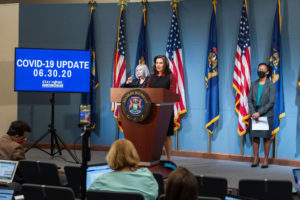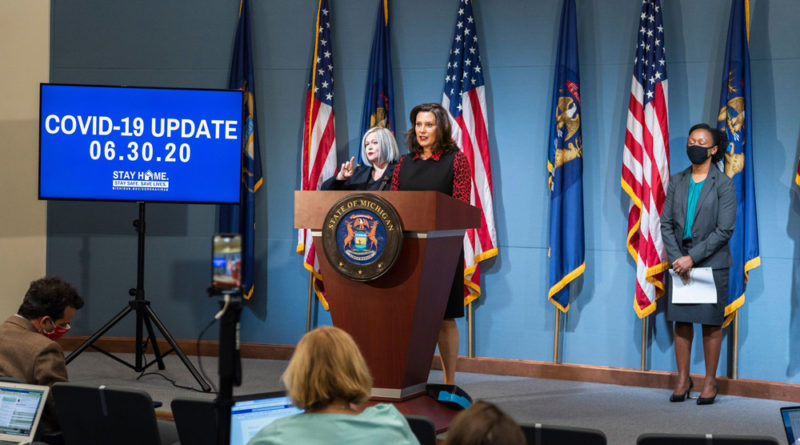Governor reveals plan to reopen schools safely in the fall
 “Right now, Michigan is still in good shape in our fight against novel coronavirus (COVID-19). We are in a stronger position than many other states that are seeing a major resurgence. A lot of states are seeing cases grow exponentially and worrying that their intensive care units are filling up. We are not in that position, but our numbers are not as strong today as they were a couple of weeks ago,” said Gov. Gretchen Whitmer in a Tuesday press conference.
“Right now, Michigan is still in good shape in our fight against novel coronavirus (COVID-19). We are in a stronger position than many other states that are seeing a major resurgence. A lot of states are seeing cases grow exponentially and worrying that their intensive care units are filling up. We are not in that position, but our numbers are not as strong today as they were a couple of weeks ago,” said Gov. Gretchen Whitmer in a Tuesday press conference.
“Over the past weeks we have seen some examples of what can happen if we drop our guard, when Michiganders don’t wear a mask or don’t practice social distancing.”
She referred to a crowded bar in Lansing that has led to more than 100 cases of COVID-19 so far as an example of what not to do. She said examples like this are not unique to Michigan, but are happening all over the country.
“We have to learn from this instance in Michigan,” she said. The virus is affecting people of all ages, with the age group of 20-29 showing a dramatic increase in the past month. Just one person who lets their guard gown can have an effect on countless others, she said.
“After three months of hard work and real sacrifice to bend the curve to protect families from this virus, we have seen preventable spread in areas across our state. We can’t let our guard down,” she urged, suggesting people celebrate Independence Day in a more private way, rather than with large groups of people.
She encouraged the use of masks to protect each other from the spread of the virus.
WHITMER RELEASED the MI Safe Schools Return to School Roadmap (MSSP), a to help districts create local plans for in-person learning in the fall. The road map outlines a number of safety protocols for schools to implement in each phase of the governor’s MI Safe Start Plan. The governor also signed Executive Order (EO) 2020-142, that provides a structure to support all schools in Michigan as they plan for a return of PreK-12 education in the fall.
EO 2020-142 requires school districts to adopt a COVID-19 Preparedness and Response Plan laying out how they will protect students and educators across the various phases of the MSSP. The MI Safe Schools Return to School Roadmap offers guidelines as to the types of safety protocols that will be required or recommended at each phase. In recognition that these protocols will cost money, the governor also announced that she was allocating $256 million to support the districts in implementing local plans as part of the bipartisan budget agreement the Senate majority leader, the speaker of the House, and the governor announced Monday.
The safety protocols detailed in the MSSP includes guidance on the use of personal protective equipment, good hygiene, cleaning/disinfecting, spacing in classrooms, screening for symptoms, athletics, and more. The road map also recognizes the impact COVID-19 has had on students’ and educators’ metal health, and offers guidance on how schools can address this issue.
Whitmer will continue to use the MSSP as the highest-level governing framework for determining if and when it is safe to resume in-person instruction.
On June 3, the governor announced a group of 25 leaders in health care and education to serve on the COVID-19 Return to Learn Advisory Council. The council is chaired by Tonya Allen, and includes public health experts, a pediatrician, educators, school administrators, school board members, community leaders, parents and students. The council will continue to work closely with the governor as she continues to put the health and safety of students and educators first. The governor announced last week that Michigan schools may resume in-person learning in phase 4 of the MSSP, with strict safety measures in place.
The advisory council was created to identify the critical issues that must be addressed, provide valuable input to inform the process of returning to school, and ensure a smooth and safe transition back to school. The council will act in an advisory capacity to the governor and the COVID-19 Task Force on Education, and will continue to develop recommendations regarding the safe, equitable, and efficient K-12 return to school in the fall.
To view the governor’s MI Safe Schools Roadmap, click here. To view Executive Order 2020-142, click the link below:
In other COVID-19 related news:
–The Michigan Department of Health and Human Services (MDHHS) is making it easier than ever for residents to find nearby COVID-19 testing sites and to register to be tested – whether they are internet-savvy or prefer to use the telephone.
MDHHS has launched a new online test finder tool at Michigan.gov/CoronavirusTest with filters that allow users to find the closest testing sites that meet their needs. Using these new filters, Michiganders can easily locate test sites that are no cost, that test people who do not have symptoms, that do not require a doctor’s order, or are for uninsured individuals. For select testing sites, users can schedule an appointment online.
The department also announced it is working with Michigan 211 to help residents find test sites and register for testing over the telephone. Anyone who calls the Michigan COVID-19 hotline Monday-Friday from 8 a.m. to 5 p.m., at 888-535-6136, and press
–The Canada Border Services Agency (CBSA) is reminding all travelers, that travel restrictions are still in place at all Canadian international border crossings. These measures remain in place until at least July 21.
All travel of an optional or discretionary nature, including tourism, recreation and entertainment, is covered by these measures across all ports of entry in all modes of transportation: land, marine, air and rail.
With the travel restrictions still in place, foreign nationals, including U.S. citizens, will not be allowed to enter Canada if they attempt to come for any of the following examples of discretionary travel including opening or checking on a cottage or seasonal home, sightseeing, boating across the border, fishing or hunting, visiting friends or a girlfriend, boyfriend or fiancé(e), attending a party or celebration, driving in transit for the purpose of taking a shortcut through Canada to get to a United States (U.S.) destination faster or picking up a pet.

